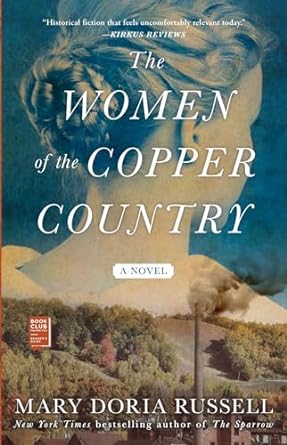Reading Between the Lines: Big Annie looms large in ‘The Women of the Copper Country’
by Mary Jo David

The story of Big Annie doesn’t leave you with warm fuzzies, but it does leave you with an appreciation for Michigan history—the good, the bad, and the ugly. Image credit: Amazon.com
“The Women of the Copper Country” was an accidental read—just a book I happened upon at the library—showcased on a shelf with other stories that take place in Michigan.
Mary Doria Russell does an excellent job recreating a fictional accounting of the real-life story of Annie Clements—or “Big Annie,” as she is called—who helped to spearhead a major strike against Calumet & Hecla, the largest copper mining company in Michigan, in 1913.
Thanks to the rich vein of copper running below ground, in the early 1900s Calumet rivaled many of the big towns in the Midwest. According to Russell, despite being located in the northwest reaches of Michigan’s Upper Peninsula…on the windswept shores of Lake Superior…and averaging annual snowfalls of 10-to-15 feet, Calumet grew into a centerpiece industrial city. It boasted electricity, an opera house, its own streetcar system, and, in 1910, more churches per capita than any other town in America.
The novel’s prologue takes the reader back to 1903, when “Big Annie” was only 16 years old and very resentful of the nickname she was tagged with due to her uncommon height. She and her father share a special moment in that prologue, during which, her father tells her, “Stand up straight, Anna. Hold your head high. That’s your strength…When your head is high, you can see farther than anyone else.” Her father’s words prove to be quite prescient ten years later, when the community looks to Annie for her strength and leadership.
Initially, the book focuses not on Annie but on James MacNaughton, general manager of Calumet & Hecla mining company. As a man “of iron habits,” whose rituals never vary, the reader does not initially know what to make of MacNaughton. He oversees a copper empire that outshines all in the area, and his fastidiousness and apparent OCD paint a picture of a man who is stubbornly set in his ways. At the same time, his appreciation for bringing some quality-of-life aspects to the miners and their families—like home gardens and shower houses—provides a puzzling counterbalance to this man who is later at the center of the miners’ uprising in 1913 and who is probably solely responsible for the strike going on as long as it did.
Soon, though, the story comes around to Annie and the home she makes for her husband, Joe Clements and three Italian boarders. Children do not figure into the equation for Annie and her abusive husband, so while other women are overwhelmed caring for children and spouses, Annie is eventually compelled to action outside her home, beginning with joining the local Women’s Auxiliary.
The Calumet mining workforce of that era was comprised of a patchwork of miners—Finnish, Italians, Swedes, to name a few. While the language barrier was very real, the women of the Auxiliary managed to work around this problem in recognition of common needs for supporting their families.
Meanwhile, unrest was growing among the miners of Calumet due to hazardous working conditions and the introduction of the one-man drill. The author describes these, along with the 12-hour days and six-day workweeks of the miners and the questionable conditions in which they were expected to work. But the main focus of “The Women of the Copper Country” is evident in the book’s title—it’s Calumet’s women. And at the head of the pack, quite literally, as she leads miners’ parades during the almost yearlong strike that is a focal point of the book, is Big Annie.
Through the involvement of fictional newspaper photographer, Michael Sweeney, who lands in Calumet in time for the miners’ uprising, Big Annie becomes the face of the Calumet copper mine strike in newspapers across the country. At the young age of 25, Annie endures physical harm, bears constant emotional stress as she carries responsibility for 10,000 workers’ lives and their families, and eventually even faces imprisonment.
Russell creates many engaging fictional characters, like Sweeney, but also includes important real characters in her story. “Big Annie” did exist in Calumet in 1913 and has been referred to as “America’s Joan of Arc” for her role leading the copper miners in their legendary strike. The author also weaves in mention of national union leaders of the era and key women who led workers’ rights charges across the country, including American labor organizer Mother Jones and political activist Ella Reeve Bloor.
As an avid reader who always appreciates happy endings, I must warn that this story does not paint a rosy picture. Instead, the reader is faced with accurate depictions of workers’ struggles in a part of the country that was harsh and unforgiving—in business, in politics, and even in weather. Truth be told, one key event, a true event, which shall remain unnamed so as to not spoil the read, will likely leave most readers in tears.
But to avoid this novel would be a mistake. Following the story of Big Annie doesn’t leave you with warm fuzzies, but it does leave you with an appreciation for Michigan history—the good, the bad, and the ugly.

Mary Jo David
Mary Jo David has put on her book reviewer hat, at least temporarily, to fill in for Shuyler Clark who was the face of “Reading between the Lines” for two years. Stockbridge Community News would like to thank Shuyler for her longtime commitment to our readers, and we wish her well in her future endeavors.

